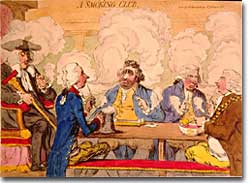2d. The Growth of the Tobacco Trade

Among 18th-century Europeans, tobacco smoking indicated a high social class. In this 1793 etching by James Gillray, wealthy men are seen indulging in tobacco at what was known as a "smoking club."
Virginia's economic future did not lie with gold. There was too little gold to be found there. Looking for new ways to make its investments pay dividends, the Virginia Company of London began encouraging multiple ventures by 1618.
Jamestown settlers experimented with glassblowing, vineyard cultivation, and even silkworm farming. Despite efforts to diversify Virginia's economy, by the end of the 1620s only one Virginia crop was drawing a fair market price in England: tobacco.
Drinking Smoke
Tobacco was introduced to Europe by the Spanish, who had learned to smoke it from Native Americans. Despite some early criticism of "drinking smoke," tobacco became popular among the middle classes in England. Much of the tobacco smoked in England was grown in the West Indies.
|
There is an herb called uppowoc, which sows itself. In the West Indies it has several names, according to the different places where it grows and is used, but the Spaniards generally call it tobacco. Its leaves are dried, made into powder, and then smoked by being sucked through clay pipes into the stomach and head. The fumes purge superfluous phlegm and gross humors from the body by opening all the pores and passages. Thus its use not only preserves the body, but if there are any obstructions it breaks them up. By this means the natives keep in excellent health, without many of the grievous diseases which often afflict us in England. – Thomas Hariot, A Brief and True Report of the New Found Land of Virginia (1588) | ||
|
Smoking is a custom loathsome to the eye, hateful to the nose, harmful to the brain, dangerous to the lungs, and in the black, stinking fume thereof nearest resembling the horrible Stygian smoke of the pit that is bottomless. – James I of England, A Counterblaste to Tobacco (1604) | ||

Known among his peers as "an ardent smoker," John Rolfe introduced the tobacco plant to the Virginia colony. This plant became the cornerstone of the Virginia economy.
John Rolfe thought that Virginia might be an outstanding site for tobacco growth. Early attempts to sell Virginian tobacco had fallen short of expectations. Smokers felt that the tobacco of the Caribbean was much less harsh than Virginian tobacco.
Rolfe reacted to consumer demand by importing seed from the West Indies and cultivating the plant in the Jamestown colony. Those tobacco seeds became the seeds of a huge economic empire.
By 1630, over a million and a half pounds of tobacco were being exported from Jamestown every year.
The tobacco economy rapidly began to shape the society and development of the colony. Growing tobacco takes its toil on the soil. Because tobacco drained the soil of its nutrients, only about three successful growing seasons could occur on a plot of land. Then the land had to lie fallow for three years before the soil could be used again. This created a huge drive for new farmland.

Tobacco cultivation was demanding work. Signs such as this one were posted in England to round up more workers (indentured servants).
Settlers grew tobacco in the streets of Jamestown. The yellow-leafed crop even covered cemeteries. Because tobacco cultivation is labor intensive, more settlers were needed.
Indentured Servants
Indentured servants became the first means to meet this need for labor. In return for free passage to Virginia, a laborer worked for four to five years in the fields before being granted freedom. The Crown rewarded planters with 50 acres of land for every inhabitant they brought to the New World.
Naturally, the colony began to expand. That expansion was soon challenged by the Native American confederacy formed and named after Powhatan.
Virginia Statute for Runaway Slaves
"Whereas there are divers loytering runaways in the collony who very often absent themselves from their masters service, And sometimes in two or three monthes cannot be found, whereby their said masters are at great charge in finding them, And many time s even to the loss of their year's labour before they be had, Be it therefore enacted and confirmed that all runaways that shall absent themselves from their said masters service shall be lyable to make satisfaction by service at the end of their tymes by indenture double the tyme of service soe neglected, And in some cases more if the comissioners for the place appointed shall find it requisite and convenient. And if such runaways shall be found to transgresse the second time or oftener (if it shall be duely proved against them) that then they shall be branded in the cheek with the letter R. and passe vnder the statute of incorrigible rogues."
– Statute passed by the Virginia House of Burgesses, from William Waller Hening's The Statutes at Large, Being a Collection of all the Laws of Virginia from the First Session of the Legislature (March, 1642)








